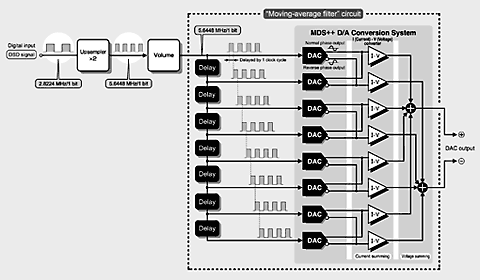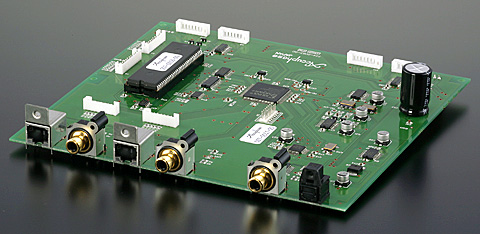MDSD is a new technology for further reducing noise during playback of Super Audio CD (SA-CD) sources. The signal recorded on the SA-CD (2.822 MHz, 1 bit DSD signal) has a very wide frequency response and dynamic range, but by principle it contains significant quantization noise components outside the range of human hearing, mainly in the region above 100 kHz. MDSD uses a combination of double speed operation and a moving-average filter circuit to eliminate these ultra high frequency noise components.
MDSD operation principle
(1) Double speed operation
The illustration shows the MDSD used in the DC-801. The 1-bit DSD signal from the input is first upsampled by a factor of two, from 2.822 to 5.644 MHz (hence the "Double Speed" name). This has the effect of smoothing frequency response in the audible range and allowing the subsequent moving-average filter to operate effectively.
(2) Moving-average filter
After volume processing, the timing of the 1-bit signal is shifted progressively in increments of 177 nanoseconds (about 5,600,000th of a second), using high-performance circuitry. The resulting delayed signals are sent to multiple D/A converters (eight per channel in the DC-801) for conversion into analog form. The converter outputs are then summed. Signal components with precipitous changes, i.e. high frequencies are sequentially averaged, so that the entire circuit acts as a high-cut filter that removes unwanted noise components in the high frequency range.
Because the MDSD can directly decode the 1-bit signal, it does not add spurious noise like a conventional digital filter does. The overall effect is totally natural filtering.

Figure Configuration Diagram of MDSD

Digital Signal Processing Block of DC-801 Using MDSD Principle
 Accuphase Laboratory, Inc.
Accuphase Laboratory, Inc.
enrich life through technology

